Con esta reseña del PSG queremos felicitar al Club que esta de moda en Europa tras ganar la Champions League 2025.
FOUNDATION AND HISTORY OF PSG
Paris Saint-Germain FC: Foundation, Club Philosophy, Honours.
Paris Saint-Germain Football Club was founded in 1970 following the merger of two clubs: Paris Football Club (founded in 1969) and Stade Saint-Germanois, a historic team established in 1904. The club was born with the ambition to represent both the city of Paris and the nearby commune of Saint-Germain-en-Laye on the capital’s outskirts..
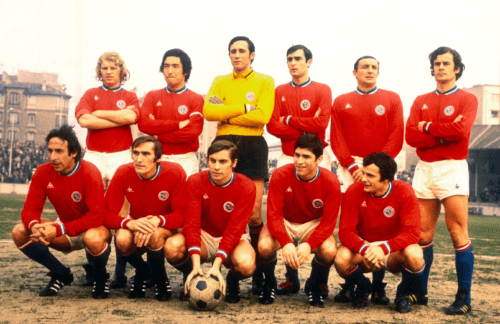
PSG season 1970-1971
After a somewhat turbulent start and a split from Paris FC, PSG rose to the top tier of French football in the mid-1970s. During this period, the club won its first major trophies, including the Coupe de France in 1982 and 1983. It was a formative stage in building the club’s identity and fanbase, which grew rapidly as Parisians longed for a top-flight team to represent the capital.
PSG claimed their first Ligue 1 title in 1986 and won it again in 1994. The club also added more Coupe de France titles in 1993, 1995 and 1998. In 1996, they achieved their greatest European success of the 20th century by lifting the UEFA Cup Winners’ Cup. The 1990s truly established PSG as one of France’s biggest clubs, highlighted by a Champions League semi-final appearance in 1995.
From 1999 onwards, the club experienced ups and downs, both on and off the pitch. Institutional changes often influenced the club’s direction, and PSG struggled for consistency in Ligue 1, even flirting with relegation in 2007. Still, there were moments of success, including winning the Coupe de la Ligue in 2008 and adding more Coupe de France titles in 2004, 2006 and 2010.
Everything changed with the arrival of Qatari investment. PSG reclaimed the Ligue 1 title in 2013 and have remained dominant in French football ever since—winning the league again in 2014, 2015, 2016, 2018, 2019, 2020, 2022, 2023, 2024 and 2025.
They also secured multiple domestic doubles, lifting the Coupe de France in 2014, 2015, 2016, 2017, 2018, 2020, 2021 and 2025.
These impressive achievements confirm Paris Saint-Germain’s transformation into a footballing powerhouse in France. And of course, 2025 marked the club’s ultimate international triumph: finally lifting the UEFA Champions League. This crowning moment came after their runner-up finish in 2020, showing their continued ambition on the European stage.
IDENTITY, CREST AND THE EVOLUTION OF PSG SHIRTS
PSG has always been a club that blends style with ambition. From the very beginning, it aimed to reflect the Parisian identity — not only through modern, attacking football on the pitch but also off it. During Daniel Hechter’s presidency (1974–1978), the club embraced the elegance and fashion-forward spirit of the capital. This influence was clearly reflected in its kits, which were ahead of their time — both stylish and sophisticated.
Between 1970 and 1973, Paris Saint-Germain wore a red shirt with blue and white accents, echoing the colours of both Paris and Saint-Germain-en-Laye. The club’s most iconic design, known as the “Hechter shirt”, was introduced in 1973 by Daniel Hechter himself. It featured a navy blue base with a bold vertical red stripe flanked by thin white lines. This design became a symbol of the club’s identity and has remained part of PSG’s DNA — regularly used in cup competitions and revived, such as in the 2020–21 season to celebrate the club’s 50th anniversary.
During the 1990s and 2000s, PSG shirts evolved further with more modern materials and alternative styles. Designs included Eiffel Tower-inspired brushstroke patterns and more artistic, impressionist-style prints, reflecting both innovation and the club’s continued ties to the aesthetic and cultural flair of Paris.
.
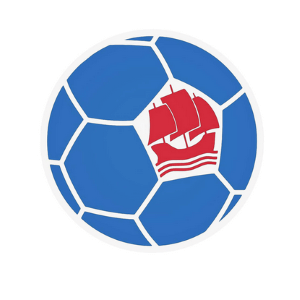
PSG's first crest
The club’s crest has also evolved in step with its identity. The very first emblem (1970–72) featured a blue football with a red ship placed over one of its white panels. In 1972, the now-iconic red Eiffel Tower was introduced as the central element, firmly establishing PSG’s Parisian roots and cultural heritage. Beneath it appeared a royal cradle and a fleur-de-lis, referencing Saint-Germain-en-Laye — the birthplace of King Louis XIV. The fleur-de-lis, a symbol of French royalty, added historical depth to the design.
In 1982, a depiction of the Parc des Princes stadium was added and remained part of the crest until 1990. After several variations during the 1990s, the historic version made a return in 1996. A major redesign arrived in 2013, modernising the logo with a stronger emphasis on the word “PARIS” while simplifying the visual elements — keeping the fleur-de-lis but removing the royal cradle. This update reflected a move to reinforce the club’s global image while staying connected to its heritage.
.
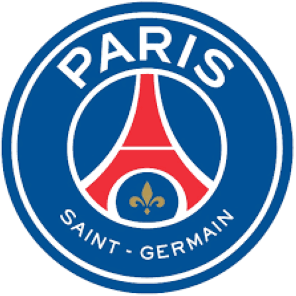
PSG's actual crest
RIVALRIES BETWEEN PSG AND OLYMPIQUE DE MARSEILLE
Paris Saint-Germain’s most iconic rivalry is with Olympique de Marseille, in the famous “Le Classique”, the French football classic. This clash, which began to intensify in the 1980s and early 1990s, represents a strong opposition between the capital (Paris) and the south (Marseille), and has been filled with tension both on the pitch and among supporters. Their two stadiums, OM’s Stade Vélodrome and PSG’s Parc des Princes, reach fever pitch at every encounter. It’s worth noting that until this year, 2025, Olympique de Marseille was the only French club to have won the UEFA Champions League, adding even more pressure on the Parisian side to conquer the title.
As for other clubs from the city of Paris, only PSG has played in Ligue 1 in recent years, despite Paris having several professional football clubs, such as Red Star Paris in the St-Ouen district or the now amateur Racing Club Paris; both teams have won the French Cup five times in their history. And this year, PSG will face a city rival in Ligue 1, as Paris FC returns to the top flight after 46 years.
.
LEGENDARY PSG PLAYERS
PSG has been home to great legends. During the 1990s, figures such as Luis Fernández and Dominique Bathenay were associated with the club’s celebrated domestic cup campaigns. In the modern era, players like Ronaldinho, Pauleta, Ibrahimović and Mbappé have rewritten the club’s history with their talent and charisma.
But today we’re going to focus on four historic foreign players of PSG:
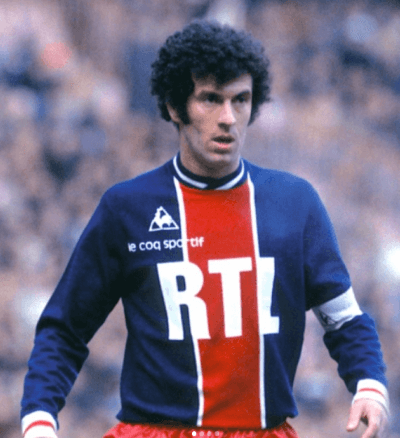
Mustapha Dhaleb PSG
Mustapha Dhaleb : A fantastic Algerian attacking midfielder, he was a legend for PSG and the Algerian national team in the 1970s and 1980s. Born in Béjaïa, Algeria, in 1952, he began his career in 1969 with CS Sedan-Ardennes and was loaned out in 1971 to Algerian side CR Belouizdad before joining Paris Saint-Germain in 1974, where he remained until 1984. During that period, from 1974 to 1984, he was Paris Saint-Germain's all-time top scorer in the French championship with 85 goals, and in 1977 he was voted the best foreign player in the championship by France Football. With PSG he won the French Cup in 1982 and 1983.
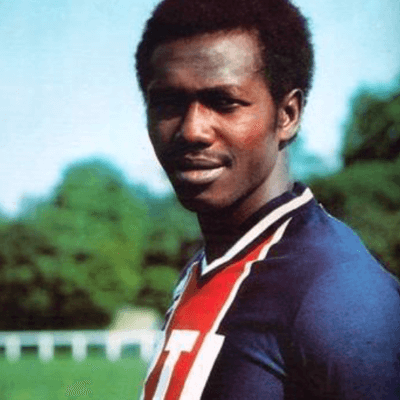
Nabatingue Toko PSG
Nabatingue Toko : Born in 1952 in Chad, the striker played for PSG between 1980 and 1985, after playing for OGC Nice, RC Strasbourg and Valenciennes. With his powerful physique, he played an important role in attack, providing goals and assists during a crucial period of growth for the club. He was part of the team that won the French Cup in 1982, PSG's first major title, scoring in the final. He won the Coupe de France again in 1983. He is also remembered in PSG history for scoring the club's first goal in a Cup Winners' Cup match. Although he was not a superstar, his performances were key at decisive moments. In Paris, he made 171 appearances and scored 43 goals. That is why we highlight him today: because football is written with names like his.
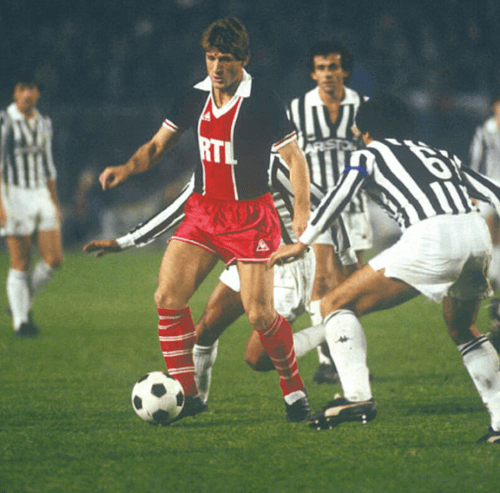
Safet Sušić PSG
Safet Sušić : This midfield player was known as Pape. He was born in 1955 in Zavidovići, in the former Yugoslavia, today part of Bosnia and Herzegovina. He played for FK Sarajevo no less than 600 times and scored no less than 400 goals. In 1982 he started playing for PSG, where he became a club legend in the 1980s until 1991 when he left the club. With the club he won the Ligue 1 in 1986 and the Cup in 1981 and PSG fans do not forget him and consider him one of their most loved stars. He finished his career at the Red Star de Saint-Ouen in Paris. Gerd Müller, the famous German striker of the 1970s, said of him that many of his teammates should have paid to play alongside him!
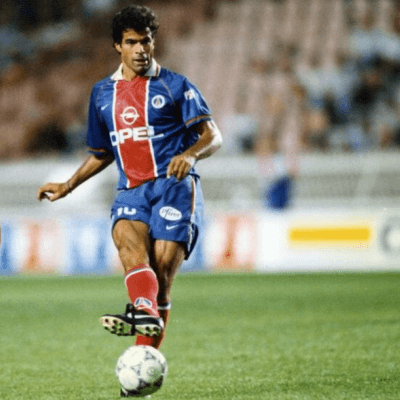
Raí PSG
Raí Souza Vieira de Oliveira : Born in Brazil in 1965, he joined Paris Saint-Germain in 1993 from São Paulo FC, where he had already shone as a Copa Libertadores champion in 1992 and 1993. Although his early days in Paris were not easy, he became a key figure in the team and one of the most respected idols of the fans. An elegant, technical and visionary attacking midfielder, he stood out not only for his decisive goals and class on the pitch, but also for his quiet leadership and sportsmanship. He was team captain and symbol of PSG during one of its most successful periods. With the Parisian club, he won six titles, including Ligue 1 (1993-94), two French Cups (1995 and 1998), two League Cups, a French Super Cup and, above all, the historic European Cup Winners' Cup in 1996. His influence in the dressing room and his performance in big matches made him a true legend at the Parc des Princes.
***
Finally, we leave links to 2 PSG children's shirts from the 70s and 80s so that all parents can proudly enjoy their passion for football with their children wearing historic shirts. As you can see below we include, the Hechter shirt, in two versions with V-neck and polo neck from two different periods.
Paris 1976-79 retro shirt | Kid
Paris 1981-82 retro shirt | Kid
***
After this brilliant year 2025, which will be remembered by all PSG fans in a hundred years' time, it remains to be seen how the Parisian capital club will evolve. Will this achievement be the beginning of a race to win several Champions League trophies?
In twenty years' time, let's take a look back!
 Retrofootball
Retrofootball  Belgium
Belgium  France
France  Germany
Germany  Italy
Italy  Portugal
Portugal  Spain
Spain  Switzerland
Switzerland  United Kingdom
United Kingdom  other countries
other countries  Retrorugby
Retrorugby 
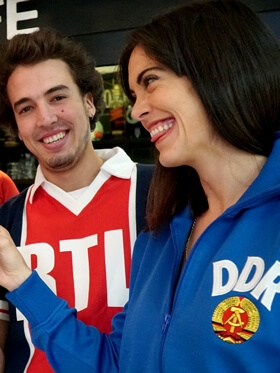
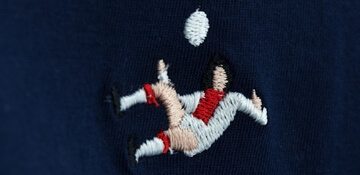
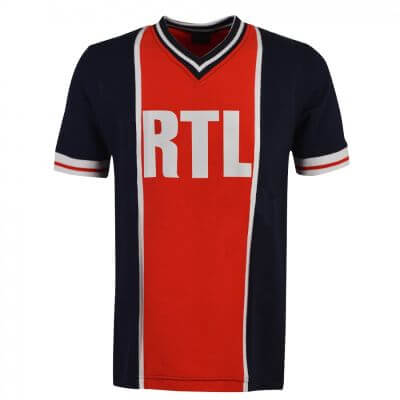
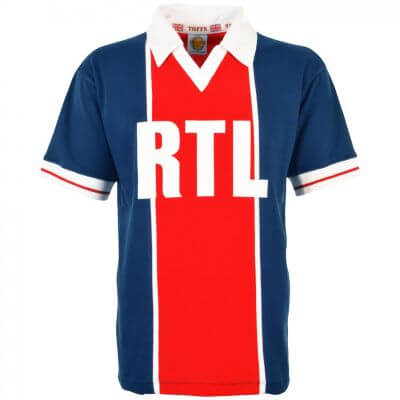




Post Comments